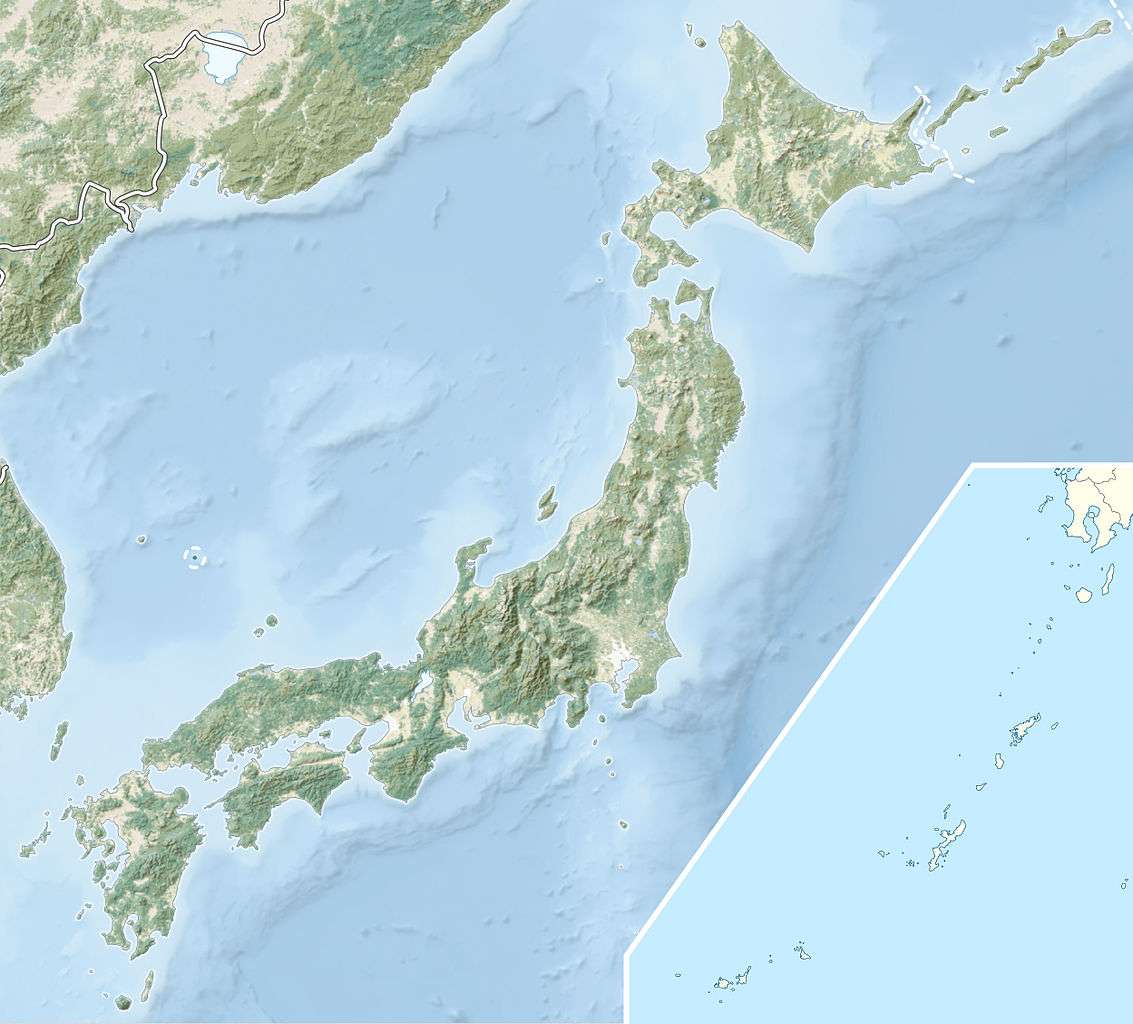2016 Fukushima earthquake
 | |
| Date |
November 21, 2016 (November 22, local) |
|---|---|
| Origin time |
20:59:49 UTC (05:59:49 JST) |
| Magnitude | 6.9 (Mwb) |
| Depth | 11.4 km (7 mi) |
| Epicenter | 37°23′31″N 141°24′11″E / 37.392°N 141.403°ECoordinates: 37°23′31″N 141°24′11″E / 37.392°N 141.403°E |
| Areas affected | Japan |
| Max. intensity | VII (Very Strong) |
| Tsunami | Yes (up to 1.4 m) |
| Aftershocks | 85[1] |
| Casualties | 15 injured (3 serious) |
The 2016 Fukushima earthquake struck Japan with a moment magnitude of 6.9 east-southeast of Namie, Fukushima Prefecture at 05:59 JST on November 22 (20:59 Nov 21 UTC), at a depth of 11.4 km (7.1 mi). The shock had a maximum intensity of VII (Very Strong) on the Mercalli scale. The earthquake was initially reported as a 7.3 magnitude by Japan Meteorological Agency, which was later upgraded to a 7.4, while the United States Geological Survey and GFZ Potsdam determined a magnitude of 6.9. It was reported to be an aftershock of the 2011 earthquake.
Fifteen people were injured during this earthquake, three of them seriously. Minor damage was caused, with reports of fires. The Fukushima Daini Nuclear Power Plant had one of its spent fuel cooling systems shut down briefly, though no measurable change in radiation levels was detected. A tsunami warning was issued with waves predicted up to 3 metres (9.8 ft), though actual waves were recorded between one and two meters in height.
Earthquake
The earthquake was a magnitude 6.9 earthquake which struck Japan 37 km (23 mi) east-southeast of Namie, Fukushima Prefecture at 05:59 JST on November 22, 2016 (20:59 Nov 21 UTC), at a depth of 11.4 km (7.1 mi).[2][3] The earthquake was initially reported as having a magnitude of 7.3 by the Japan Meteorological Agency, who later upgraded the magnitude to 7.4, while the United States Geological Survey and GFZ Potsdam reported it as having a magnitude of 6.9 Mwb.[4]
The shock had a maximum intensity of VII (Very Strong) on the Mercalli scale.[5] The Japan Meteorological Agency stated it was an aftershock of the 2011 earthquake.[6][7]
Tsunami
The Japanese authorities advised people from the coastal region of Fukushima to evacuate immediately due to a possible tsunami with waves of up to 3 metres (9.8 ft).[8] Waves of up to a meter in height struck the Fukushima coast about an hour after the earthquake, and public broadcaster NHK reported the presence of a tsunami of 1.4 metres (4.6 ft) at the Sendai ward of Miyagi Prefecture.[9][10][11]
Impact
Fifteen people were injured during the earthquake, including broken bones and cuts from falling objects, three of them seriously.[12] Minor property damage was recorded.[13] There was a fire at a research facility in Iwaki.[14] A brief power outage was reported for about 1,900 houses.[5] Local and express trains, including the Shinkansen, were out of service for time to allow for the tracks to be inspected.[14]
The earthquake caused the third reactor's spent fuel cooling systems of the Fukushima Daini Nuclear Power Plant to stop, though circulation was restored after about 100 minutes.[5][11][15] The radiation levels were unchanged following the brief shutdown.[16][17]
The Nikkei futures market in Japan was not significantly impacted.[14]
See also
References
- ↑ Mochizuki (November 23, 2016). "Aftershocks occurred over 85 times by 11am of 23rd Nov after M7.4".
- ↑ "M6.9 - 37km ESE of Namie, Japan". United States Geological Survey. November 21, 2016. Retrieved November 21, 2016.
- ↑ Obayashi, Yuka; Mallard, William (November 21, 2016). "Tsunami hits Japan after strong quake, nuclear plant briefly disrupted". Reuters. Retrieved November 21, 2016.
- ↑ "Live: Tsunami after earthquake strikes off Fukushima in Japan". Australian Broadcasting Corporation. Retrieved November 22, 2016.
- 1 2 3 Grinberg, Emanuella; Westcott, Ben. "7.3-magnitude earthquake strikes off Japan". CNN. Retrieved November 21, 2016.
- ↑ Robson, Steve; Haworth, Jessica; Bishop, Rachel (November 23, 2016). "Fukushima earthquake: Live updates as tsunami hits coast of Japan". Mirror. Archived from the original on November 23, 2016. Retrieved November 23, 2016.
- ↑ "Fukushima: Japan lifts tsunami alert after 7.4 quake". BBC News. November 22, 2016. Archived from the original on November 28, 2016. Retrieved November 28, 2016.
- ↑ "Tsunami-waarschuwing voor Fukushima na zware aardbeving" (in Dutch). NU.nl.
- ↑ "Japan earthquake: Tsunami after quake strikes off Fukushima". ABC Online. November 22, 2016. Retrieved November 22, 2016.
- ↑ "Seismic activity continues off Fukushima". NHK World. November 23, 2016. Retrieved November 23, 2016.
- 1 2 Fifield, Anna (2016-11-22). "Tsunami warning for Japan's Fukushima coast after 6.9-magnitude earthquake". The Washington Post. Naha, Japan. ISSN 0190-8286. Retrieved 2016-11-23.
- ↑ "福島沖地震、51万人に避難指示・勧告 14人が負傷" [Fukushima ocean earthquake, 510,000 people advised to evacuate, 14 people injured] (in Japanese). November 22, 2016. Archived from the original on November 24, 2016. Retrieved November 24, 2016.
- ↑ Breslin, Sean (November 22, 2016). "Strong Japan Earthquake Produces Tsunami but Spares Major Damage". The Weather Channel. Retrieved November 23, 2016.
- 1 2 3 "Tsunami Hits Off Japan's Fukushima Coast After Powerful Earthquake". Fortune.com. November 21, 2016. Archived from the original on November 23, 2016. Retrieved November 23, 2016.
- ↑ "TEPCO to study cooling system stoppage". NHK World. November 22, 2016. Retrieved November 23, 2016.
- ↑ "Offshore quake causes tsunamis, nuclear worries in Japan". Fox 6. November 21, 2016. Archived from the original on November 23, 2016. Retrieved November 23, 2016.
- ↑ "6.9-magnitude earthquake strikes off Japan". KTVZ. November 21, 2016. Archived from the original on November 23, 2016. Retrieved November 23, 2016.
External links
- Earthquake in Japan on Earthquake Report Website